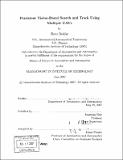| dc.contributor.advisor | Jonathan How. | en_US |
| dc.contributor.author | Bethke, Brett (Brett M.) | en_US |
| dc.contributor.other | Massachusetts Institute of Technology. Dept. of Aeronautics and Astronautics. | en_US |
| dc.date.accessioned | 2008-02-27T22:20:08Z | |
| dc.date.available | 2008-02-27T22:20:08Z | |
| dc.date.copyright | 2007 | en_US |
| dc.date.issued | 2007 | en_US |
| dc.identifier.uri | http://hdl.handle.net/1721.1/40392 | |
| dc.description | Thesis (S.M.)--Massachusetts Institute of Technology, Dept. of Aeronautics and Astronautics, 2007. | en_US |
| dc.description | Includes bibliographical references (p. 93-98). | en_US |
| dc.description.abstract | Unmanned aerial vehicles (UAVs) have attracted interest for their ability to carry out missions such as border patrol, urban traffic monitoring, persistent surveillance, and search and rescue operations. Most of these missions require the ability to detect and track objects of interest on or near the ground. In addition, most of the missions are inherently long-duration, requiring multiple UAVs to cooperate over time periods longer than the endurance of a single vehicle. This thesis presents a framework to enable such missions to be carried out autonomously and robustly. First, a technique for vision-based target detection and bearing determination that utilizes a video camera onboard each UAV is presented. The technique is designed to detect the presence of targets of interest in the camera video stream and determine the bearing from the UAV to the target even when the video data is noisy. Next, a cooperative, bearings-only target estimation algorithm is presented. The algorithm is shown to provide better estimates of a target's position and velocity in three dimensions than could be achieved by a single vehicle, while being computationally efficient and naturally distributable among multiple UAVs. | en_US |
| dc.description.abstract | (cont. )Next, a task assignment algorithm that incorporates closed-loop feedback on the performance of individual UAVs and sensor suites is developed, enabling underperforming UAVs to be dynamically swapped out by the tasking system. Finally, flight results from several persistent, multiple-target search and track experiments conducted on MIT's Real-time indoor Autonomous Vehicle test ENvironment (RAVEN) are presented. | en_US |
| dc.description.statementofresponsibility | by Brett Bethke. | en_US |
| dc.format.extent | 98 leaves | en_US |
| dc.language.iso | eng | en_US |
| dc.publisher | Massachusetts Institute of Technology | en_US |
| dc.rights | M.I.T. theses are protected by copyright. They may be viewed from this source for any purpose, but reproduction or distribution in any format is prohibited without written permission. See provided URL for inquiries about permission. | en_US |
| dc.rights.uri | http://dspace.mit.edu/handle/1721.1/7582 | |
| dc.subject | Aeronautics and Astronautics. | en_US |
| dc.title | Persistent vision-based search and track using multiple UAVs | en_US |
| dc.type | Thesis | en_US |
| dc.description.degree | S.M. | en_US |
| dc.contributor.department | Massachusetts Institute of Technology. Department of Aeronautics and Astronautics | |
| dc.identifier.oclc | 191672952 | en_US |
